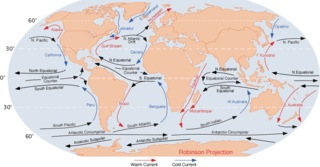邊界流
外觀
邊界流(英語:Boundary Current)是指在大陸邊緣的洋流,因此其動力受海岸線的影響。邊界流可分為兩個不同的類別:西部邊界流和東部邊界流。
東部邊界流
[編輯]東部邊界流位於大洋盆地的東側(毗鄰大陸的西海岸),其特性一般較淺、較寬而且流動緩慢。位於副熱帶的東部邊界洋流是向赤道流動的,把冷水從高緯度地區輸送到低緯度地區。本格拉洋流[1]、加那利洋流[2]、 洪堡洋流[3] 和加利福尼亞洋流(英語:California Current)[4]等均屬於東部邊界流。在這些地區的沿岸上升流,經常把富含海鮮的深水帶入東部邊界洋流區,使其成為海產豐富區域[5][6]。
西部邊界流
[編輯]西部邊界流則分為亞熱帶和低緯度西部邊界流兩種洋流。亞熱帶西部邊界洋流是由於大環流的西環強化(英語:Western intensification)作用的,而在洋盆西側形成的溫暖、深、窄和快速流動的洋流,它們從熱帶向極地方向運送溫水。墨西哥灣流[7]、阿古拉斯洋流[8]和黑潮[9]等均屬此種西部邊界流。低緯度西部邊界流類似於亞熱帶西部邊界流,但將冷水從亞熱帶流向赤道方向。棉蘭老島洋流(英語:Mindanao Current)[10]和巴西北部洋流(英語:North Brazil Current)[11]等也屬於此種西部邊界流。[12][13]。
參考文獻
[編輯]- ^ Garzoli, S. L., and Gordon, A. L. (1996), Origins and variability of the Benguela Current, J. Geophys. Res., 101( C1), 897– 906, doi:10.1029/95JC03221
- ^ M Knoll, A Hernández-Guerra, B Lenz, F López Laatzen, F Machı́n, T.J Müller, G Siedler (2002) The Eastern Boundary Current system between the Canary Islands and the African Coast,Deep Sea Research Part II: Topical Studies in Oceanography,Volume 49, Issue 17,Pages 3427-3440,ISSN 0967-0645,https://doi.org/10.1016/S0967-0645(02)00105-4
- ^ R. N. Gibson, R. J. A. Atkinson, J. D. M. Gordon( 2007). THE HUMBOLDT CURRENT SYSTEM OF NORTHERN AND CENTRAL CHILE, Oceanography and Marine Biology, CRC Press, ISBN 9780429144905
- ^ B.M. Hickery and T.C.Royer (2009) Califrona and Alaska Currents in Ocean Current, editor Steve A. Thorpe ISBN 978-0-08-096486-7
- ^ S. G. H. Philander and J-H. Yoon (1982) Eastern Boundary Currents and Coastal Upwelling, Jour. of Physical Oceanography, vol 12, issure 8. Page(s): 862–879. https://doi.org/10.1175/1520-0485(1982)012<0862:EBCACU>2.0.CO;2
- ^ Rykaczewski, R. R., Dunne, J. P., Sydeman, W. J., García-Reyes, M., Black, B. A., and Bograd, S. J. (2015), Poleward displacement of coastal upwelling-favorable winds in the ocean's eastern boundary currents through the 21st century, Geophys. Res. Lett., 42, 6424– 6431, doi:10.1002/2015GL064694
- ^ Charney J.G. (1990) The Gulf Stream as an Inertial Boundary Layer. In: Lindzen R.S., Lorenz E.N., Platzman G.W. (eds) The Atmosphere — A Challenge. American Meteorological Society, Boston, MA. https://doi.org/10.1007/978-1-944970-35-2_16
- ^ J.R.E. Lutjeharms, R. Catzel, H.R. Valentine,(1989) Eddies and other boundary phenomena of the Agulhas Current, Continental Shelf Research, Volume 9, Issue 7, Pages 597-616,ISSN 0278-4343, https://doi.org/10.1016/0278-4343(89)90032-0.(https://www.sciencedirect.com/science/article/pii/0278434389900320)
- ^ Kathryn A. Kelly, R. Justin Small,R. M. Samelson, Bo Qiu, Terrence M. Joyce, Young-Oh Kwon, and Meghan F. Cronin (2010)Western Boundary Currents and Frontal Air–Sea Interaction: Gulf Stream and Kuroshio Extension Jour of Climate Vol. 23 Issue 21, p 5644-5667.DOI: https://doi.org/10.1175/2010JCLI3346.1
- ^ Lukas, R., Firing, E., Hacker, P., Richardson, P. L., Collins, C. A., Fine, R., and Gammon, R. (1991), Observations of the Mindanao Current during the western equatorial Pacific Ocean circulation study, J. Geophys. Res., 96( C4), 7089– 7104, doi:10.1029/91JC00062
- ^ Müller, T. J., Ikeda, Y., Zangenberg, N., and Nonato, L. V. (1998), Direct measurements of western boundary currents off Brazil between 20°S and 28°S, J. Geophys. Res., 103( C3), 5429– 5437, doi:10.1029/97JC03529
- ^ Shiro Imawaki, Amy S. Bower, Lisa Beal, Bo Qiu,Chapter 13 - Western Boundary Currents,Editor(s): Gerold Siedler, Stephen M. Griffies, John Gould, John A. Church, International Geophysics,Academic Press, Volume 103, 2013, Pages 305-338, ISSN 0074-6142, ISBN 9780123918512,https://doi.org/10.1016/B978-0-12-391851-2.00013-1.(https://www.sciencedirect.com/science/article/pii/B9780123918512000131)
- ^ Hogg, N. G., and Johns, W. E. (1995), Western boundary currents, Rev. Geophys., 33( S2), 1311– 1334, doi:10.1029/95RG00491



